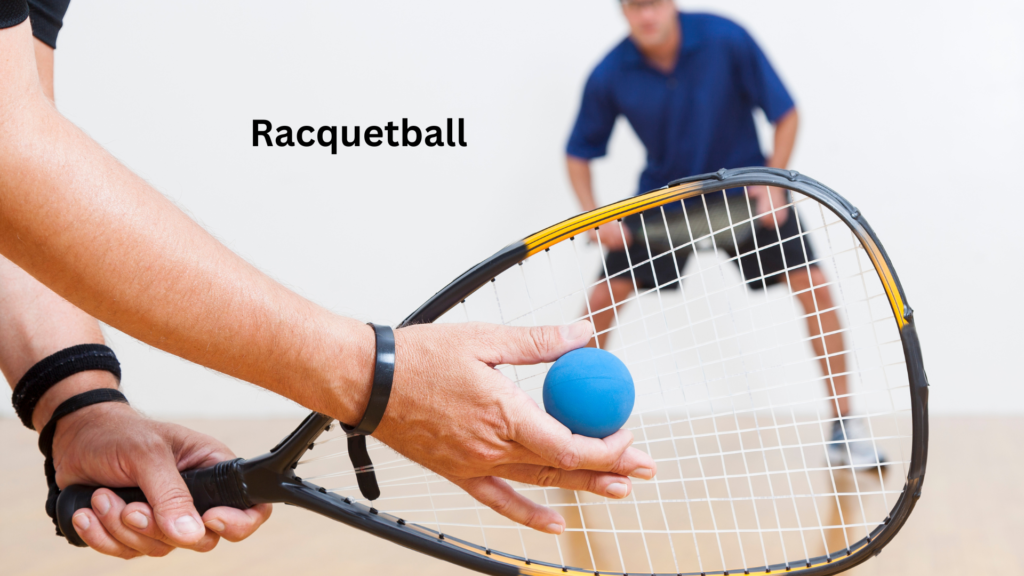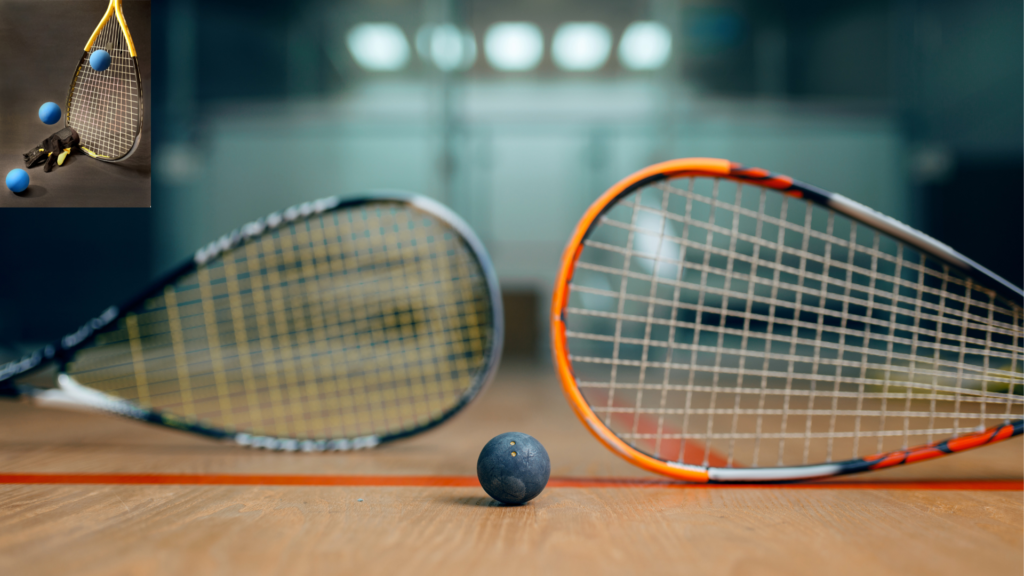Racquetball vs Squash Health Benefits Which is the Better?

If you are looking to try a new sport Fitness enthusiasts frequently are faced with the dilemma of comparing racquetball to squash. Both are fast-paced racket games that are played on courts enclosed, yet they provide distinct benefits for physical fitness. Which one is more effective for exercise? Let’s examine the benefits to their health by looking at heart fitness, muscle engagement as well as calorie burning and general mental health.
History and Origins of Racquetball vs Squash
Knowing the background and history of squash and racquetball can give an understanding of their distinct draw. Both have similar characteristics as the sport is based on rackets, their roots are very different.

- Racquetball was first played within the United States in the 1950s. It was created in the 1950s by Joe Sobek, a professional tennis and handball player who sought to develop the sport that could be played by anyone as well as fast-paced and entertaining. Combining techniques of handball, squash as well as paddleball Sobek invented a new game which was easy to learn and played with minimal equipment. This eventually led to the creation of the sport of racquetball. It gained significant traction quickly because of its quick learning curve, and its lively gameplay.
- The game of squash, on the other side, has an more lengthy history that dates from the early 19th century in England. It was developed as a variant from the more traditional game of rackets that were played in prisons as well as elite schools. People began to notice that hitting soft rubber ball would make the game more difficult and stimulating, leading to the formation of squash courts as well as the specific rules. As time passed, squash developed to become a worldwide sport frequently involving skills, strategy and the ability to endure..
Although both focus on the racket’s movement Their origins are different, revealing distinct uses for racquetball, both for speedy recreational entertainment and squash to develop strategic games and athletic skills.
Important Takeaway: Racquetball is a modern sport that is designed to be easy and accessibility. Squash is more rooted in history and is renowned for its intricate strategic structure.
Cardiovascular Fitness
Both squash and racquetball make fantastic options to improve cardio fitness. But, their levels of intensity depend on the type of the game.
- Racquetball has a bigger court as well as faster ball speeds that require players to perform explosive moves that cover more ground in less period of. The constant motion can raise the heart rate, and increase your overall endurance.
- Squash is, on its own is renowned for its strong bursts of energy on a small court. Wall shots force players to respond swiftly, depending on quick directional change and agility. Although squash might require lesser sprinting, the continuous vigorous movement helps keep your heart rate within the burning zone for prolonged time.
Winner: Both sports provide incredible cardiovascular benefits. However, squash could have an advantage due to its greater level of intensity with duration.
Muscle Engagement in Racquetball vs Squash
In comparing squash vs racquetball muscles, it is one of the most important factors. Both games use a range of muscles, but with slightly different methods.
- Racquetball is primarily focused on intense movements that use the muscles of the legs (quads as well as hamstrings, calves). A wider court requires players to sprint and lunge often, which increases lower body strength. In addition, the swinging motion will target your shoulders, arms as well as your muscles in your core.
- Squash is a great exercise for agility and fast reactions. Rapid direction shifts and the repeated lunges increase endurance and strength of the legs. Squash is also heavily reliant on rotational motions that work the obliques as well as all core muscles. Compact courts mean faster movements, with a greater importance to the shoulders and arms.
The winner: Squash could provide more continuous full body muscle involvement and racquetball can be better for intense lower-body exercises.
Equipment and Gear Differences Between Racquetball and Squash
The other important aspect when you compare squash and racquetball is the equipment and accessories required to play each. This can affect your experience overall and how you perform in the courts.
Racquetball Equipment:
Racquetball rackets are bigger and heavier. The average is around 22 inches of length. The rackets have an angular shape, that is designed to provide powerful shots as well as control. The racquetball ball is bigger, more bouncier and can travel at greater rates, which is why it’s ideal for sports with high intensity and quick-paced rallies. Eye protection is required by players since the ball may reach speeds as high as 150mph when playing professional level games.
Racquetball footwear is made using durable soles that can be used on floors made of concrete or wood that provide stability in fast sprints and other lateral movements. The walls on the court for racquetball have a significant role to play in allowing players to hit the ball through any wall in order to ensure that the game is played.
Squash Equipment:
Squash rackets are a bit smaller with a range of 27 to 28 inches of length. They’re lighter than the racquetball rackets. This permits better control in rallies that are fast. Squash balls are smaller, less bouncey, and more supple than a tennis ball, which makes players more dependent on control and precision. The squash balls differ based on the level of skill, which allows beginners to choose balls with more bounce, while experienced players prefer slow, low bounce balls.
The soles of squash-specific footwear are non-marking, made for traction on the squash courts. Eye protection is suggested, but the smaller speed of squash balls reduces the risk. In addition squash courts can be smaller and better restricted, which means they require strategic positioning and not just sheer strength.
The most important thing to remember: Racquetball features larger, more powerful equipment suitable to play at a fast pace and squash needs light and precise equipment designed to play strategically. Pick the sport that is the best with your tastes and playing style.
Calorie Burn in Racquetball vs Squash
One of the most important questions during the fitness competition is which one burns the most calories. Find out what racquetball and squash can do to measure in the rankings.
- Racquetball players consume between 700 and 800 calories an hour in the course of a match. Its high-speed moves requires a significant amount of energy. It’s an excellent choice when you’re looking to burn fat while being in shape.
- The squash sport can consume around 800-850 calories an hour. This makes it more calories-intensive in general. A rapid and dynamic move coupled with a steady effort puts loads of stress on your body. This means you burn more calories.
The winner: Squash is able to edge out the racquetball somewhat, however the difference isn’t significant, and it depends on the way you play and the intensity.
Mental Health Benefits of Racquetball vs Squash

Squash and racquetball provide additional than only physical advantages. Participating in these sports could improve your mental well-being significantly.
- It helps focus and improves the ability to make decisions. Its fast-paced sport requires players to follow the ball, and then make quick decisions. This enhances their reaction time as well as mental alertness, and the adrenaline rush helps to reduce anxiety and stress.
- The game of squash challenges your thinking process as well as your ability to anticipate your opponent’s movements. Its tactical nature will keep your brain active and alert throughout the entire game. Regular practice can boost the cognitive performance and decrease stress levels.
These sports are also great for fostering teams and social bonds, that are great for overcoming feelings of isolation as well as improving your overall health.
The winner: Both activities are equally good for mental well-being, with each providing distinct challenges to the brain.
Which Sport Offers the Better Workout?
If you’re comparing squash and racquetball the two provide excellent exercise with distinct benefits. If you like explosive bursts and a wide range of movement the racquetball game could be than you’d like. But squash’s high-intensity rally with a less crowded court offer an all-body workout as well as greater endurance.
Choosing the Right Sport for Your Fitness Goals

- Pick a racquetball for:
- The courts are bigger and you can enjoy long sprints.
- Focus on the strength of your lower-body.
- You excel in fast-paced game play, with explosive action.
- Choose squash if:
- You like smaller courts as well as rapid rallies.
- Are you looking for a fat-burning exercise that is full body.
- Your favorite games are those which challenge your body as well as your brain.
Whichever you decide to choose Incorporating either activity to your exercise routine will aid in building muscle tone, endurance and boost overall fitness. Most importantly, squash and racquetball can be extremely enjoyable that you’ll never even realize you’re exercising!
FAQs About Racquetball vs Squash
1. What’s the primary difference between squash and racquetball?
The primary difference is the play, equipment and court layout. Squash uses a larger racket and ball, it is played in a quadruple-walled court that allows for hitting any wall. Squash requires smaller balls, a light racket and an closed court that requires strategic positioning and exact shots.
2. Which one burns the most calories? Racquetball or squash?
Both squash and racquetball both are great at burning calories However, the precise quantity depends on the the intensity and length of. squash generally burns a little more calories because of its constant sprints and its higher demand on aerobic and racquetball focuses on quick energetic bursts.
3. Which is the best sport for heart health?
Both squash and racquetball offer substantial cardiovascular advantages. squash is more intense aerobically and can lead to improved heart endurance. Racquetball’s rapid pace is characterized by high intensity interval pulses, that can improve your cardiovascular health.
4. Can racquetball be taught more easily than squash?
It is thought of as being easier to learn due to its easy rules, and its larger court which makes it more tolerant of play. The game of squash requires greater precision and strategy, which makes it somewhat more challenging for those who are new to the sport.
5. What do I require for racquetball and squash?
To play racquetball, you’ll require a bigger racket, bouncy ball, eyewear that is protective, and footwear with sturdy soles. For squash players, you’ll need a smaller, lighter racket, soft balls that aren’t bouncy as well as non-marking court shoes.
6. Does playing squash or racquetball help improve mental wellbeing?
Both sports improve mental well-being by boosting concentration, reaction time, and stress-relief. Squash could require more brain strategies due to its strategic game, whereas racquetball assists in boosting reaction speed and rapid making decisions.
7. Which one is more popular either squash or racquetball?
Squash is a sport that has an international following and is particularly popular across Europe and Asia in countries where it’s seen as an official game. Racquetball is more well-known across America. United States, where it’s typically played as a recreational sport.


Your point of view caught my eye and was very interesting. Thanks. I have a question for you.
Mình hay chơi **hello88 c** trên iPad, cảm giác kéo slot đã hơn hẳn điện thoại nhỏ. Có hôm ngồi toilet chơi slot quên cả thời gian 😳
Can you be more specific about the content of your article? After reading it, I still have some doubts. Hope you can help me.